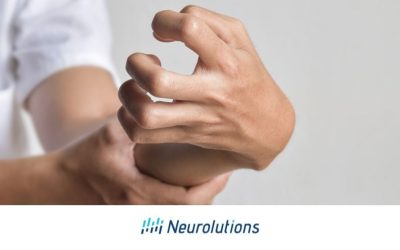What is Dysarthria?
Dysarthria can make words sound unclear, but many people can improve their speech with the right help.
Dysarthria is a speech disorder caused by weakened or uncoordinated muscles in the face, jaw, tongue, larynx, or vocal cords. It often occurs after a stroke or brain injury, making speech difficult to understand. Unlike aphasia, which affects language comprehension and word formation, dysarthria results from impaired muscle control (1).
A stroke can damage the brain’s ability to send movement signals to the muscles. This disruption affects speech production, impacting their ability to form words correctly.
Who is at Risk for Dysarthria?
People who experience nerve-damaging conditions like stroke and traumatic brain injury (TBI) can get dysarthria. But they’re not the only ones at risk. The following conditions can also cause dysarthria (2):
- Parkinson’s disease
- Amyotrophic Lateral Sclerosis (ALS)
- Multiple Sclerosis (MS)
- Benign or malignant brain tumor
- Spinal cord injury above the T-6 vertebra
Since dysarthria affects nerve and muscle function, any condition that interferes with the brain or spinal cord’s ability to send messages to the nerves controlling muscles can result in dysarthria.
Different Types of Dysarthria:
There are seven ways dysarthria can appear.
Dysarthria can appear in various forms depending on the underlying cause. The seven types of dysarthria are (3):
- Ataxic: Often caused by strokes, TBIs, or progressive nerve disorders, it results in slurred, “drunk-sounding” speech, sudden volume changes, and difficulty controlling pronunciation.Flaccid: Can occur after strokes, TBIs, congenital speech disorders, progressive nerve conditions, or cerebral palsy. It is marked by breathy or nasal speech, low muscle tone, and swallowing difficulties.
- Hyperkinetic: Common in Huntington’s disease, this type features strained or strangled-sounding speech, sudden volume changes, and involuntary head and upper-body movements while speaking.
- Hypokinetic: Associated with Parkinson’s disease, it causes a monotone voice, short and rushed speech, and low volume. It is the only type of dysarthria associated with an increased rate of speech.
- Spastic: Characterized by slow, jerky speech, a harsh voice, and muscle weakness. Those affected may visibly struggle to move the muscles needed for speech.Unilateral upper motor neuron dysarthria: Caused by nerve damage, it leads to a hoarse voice, slow speech, and difficulty forming words. It is often accompanied by facial muscle tightness.
- Mixed dysarthria: A combination of multiple dysarthria types, leading to varied speech impairments.
How Dysarthria Affects Speech in Conversations
Dysarthria makes it hard for people to speak clearly and for others to understand them. Others may mistakenly assume they have aphasia, thinking they cannot find the right words instead of struggling with muscle control.
As a result, many people with dysarthria may avoid social interactions, leading to increased feelings of isolation, depression, and loneliness. Since social engagement is crucial for brain recovery, avoiding conversations can slow down rehabilitation.
How Muscle Movement Problems Cause Dysarthria
Weak or uncoordinated muscles often lead to unclear speech, but targeted exercise can help.
Each side of the face has about 30 muscles that work together to produce speech (4). These muscles, along with those in the mouth, tongue, larynx, and vocal cords, help form words and control tone. When these muscles do not function properly, speech clarity is affected.
When these muscles don’t work right, it becomes hard to make the correct sounds in words and sentences. For example:
- Saying the vowel “A” (as in “cake”) requires stretching facial muscles. If one side of the face is paralyzed, the sound may be distorted.
- The tongue plays a key role in shaping sounds, and limited movement can affect pronunciation.
- The larynx and vocal cords control pitch, volume, and tone, impacting speech fluency.
Recognizing the Symptoms of Dysarthria
People with dysarthria may sound slurred or slow, yet they can still understand and choose words correctly.
The main sign of dysarthria in stroke or TBI survivors is that their voice changes and becomes unclear or hard to understand. Symptoms can range from mild to severe. This is different from aphasia, in which a person has difficulty in finding the right words to say or understanding the meaning of what others are saying.
It’s important to tell the difference between dysarthria and aphasia because they require different treatments. Aphasia happens as a result of damage to the brain itself, and dysarthria is linked to the nerves that control muscles. That’s why aphasia treatment focuses on retraining the brain, while dysarthria treatment works on helping facial, tongue, larynx, and vocal cord movements.
About 40-50% of people with Multiple Sclerosis (MS) have dysarthria symptoms (5). Additionally, around 90% of people with Parkinson’s disease develop hypokinetic dysarthria (6). For people with these disorders, the symptoms usually don’t improve. However, if people who have had a stroke or brain injury start speech therapy right away, many can improve their speech.
Diagnosis and Assessment of Dysarthria
Doctors and speech experts check how you move your mouth and talk to find the best treatment plan.
How Dysarthria is Diagnosed:
Diagnosing dysarthria involves a team of physicians, medical providers, speech therapists, also referred to as speech and language pathologists (SLPs). A physician will first review the patient’s medical history and conduct a physical exam. They may also order blood tests or other diagnostics to rule out underlying causes of speech difficulties
After the medical exam, an SLP evaluates the severity of the speech disorder and determines the type(s) of dysarthria present.. The SLP uses these test results to create a specific speech therapy plan for the individual.
Tools and Tests used in Dysarthria Diagnosis:
Special tests measure muscle movement and speech clarity so therapists can guide improvement.
SLPs use five key methods to assess the severity and type of dysarthria:
- Listen to how the person speaks and their voice quality
- Check how well they can move their lips, tongue, and face
- Test their swallowing ability
- Have them read out loud, repeat words/sentences, and hold conversations
Examine breath control and sound coordinationThe SLP might also check these parts of speech (7):
- Phonation: the ability to make sounds called phenomes using the larynx/vocal cords in the throat
- Articulation: how clearly someone speaks sounds and words
- Prosody: how they change pitch, loudness, and length of sounds while speaking
- Speech intelligibility: how well others can understand the words or sentences
Strategies to Manage Dysarthria
Exercises, practice, and devices help people regain clearer speech and stay social.
Speech Therapy to Improve Articulation and Other Elements of Speech Production:
Languages like English include two main types of sounds: vowels and consonants. People need to be able to move their faces and tongues in specific ways to make vowel sounds. After a stroke/TBI, a SLPs helps people relearn how to move their face, lips, and tongue correctly while speaking in order to produce these vowel sounds.
Speech therapists also help people with dysarthria improve other parts of speech. They can teach patients with lasting facial or tongue problems other ways to speak or communicate.
Exercises and Practice:
To regain clear speech, people with dysarthria can be be instructed (8):
- Speak slowly to improve pronunciation.
- Repeat difficult words for accuracy.
- Over-exaggerate mouth movements for clarity.
- Face the listener while speaking.
- Minimize background noise to enhance communication.
SLPs usually use exercises that start with easier sounds before moving to harder ones. In each session, they might ask someone to:
- Make individual sounds, such as a vowel sound
- Practice one-syllable words with each vowel sound, gradually increasing to two-syllable and three-syllable words
- Practice word pairs with the same vowel sounds, like “pen” and “hen”
- Try increasingly complex phrases and sentences
Using Assistive Communication Devices:
People with significant or severe dysarthria which does not improve might use speech-generating devices, smartphone apps, or communication boards to assist with communication. Additionally, learning to use assistive devices like speech-generating computer programs can help recovery while making communication easier.
Doctors might also use neuro-muscular electrical stimulation (NMES) to help paralyzed muscles recover faster in people with dysarthria (9).
Involving Family and Care Partners in Communication Practice:
Family, friends, and care partners can help those with dysarthria recover just by talking with them. Social activities and communication can lead to better physical and mental health outcomes for stroke and TBI survivors (10).
Damage to the brain can also affect thinking abilities like short-term memory and decision-making. Having conversations with someone who has dysarthria can help them recover both speech and thinking abilities (11). As a family member, friend, or care partner, it’s important to be patient and encourage conversation.
Dysarthria vs. Aphasia: Understanding the Differences
Dysarthria changes how words sound, while aphasia changes the words themselves.
What is Aphasia?
Aphasia affects a person’s ability to speak, understand speech, read, and write. It usually happens after a stroke or traumatic brain injury (TBI) damages specific brain areas.
There are two areas of the brain that control language: the Broca area and the Wernicke area. Broca’s aphasia makes it hard to form correct words and sentences from thoughts. Wernicke’s aphasia makes it hard to understand what others say (12).
After a stroke or TBI, Broca’s aphasia symptoms can include:
- Trouble using correct words to express thoughts. For example, saying “walk dog” instead of “I will take the dog for a walk”
- Speaking in short phrases with great effort
- Loss of normal grammar when speaking
- Leaving out small words like “and” and “the”
- Having trouble repeating what others say
Wernicke’s aphasia mainly makes it hard to understand others. Other common symptoms include:
- Speaking fluently but using words that don’t make sense
- Making long sentences without meaning
- Not being able to repeat words or phrases
Wernicke’s aphasia can make it hard for stroke/TBI survivors to follow exercise instructions from occupational and/or physical therapy (OT and/or PT). This often leads to slower movement recovery than with Broca’s aphasia.
Key Differences between Dysarthria and Aphasia:
Muscle problems cause dysarthria, but brain language areas cause aphasia, so treatments differ.
Aphasia comes from a brain injury that makes it hard to turn thoughts into words or understand others’ speech. Dysarthria happens because of muscle movement and nerve problems. People with dysarthria can think of the right words and understand others, but have trouble speaking clearly. Some stroke/TBI survivors can experience both conditions. SLPs treat both problems separately to help recover communication skills.
It’s more difficult to treat someone who has both Wernicke’s aphasia and dysarthria than someone with Broca’s aphasia and dysarthria. This is because people with Wernicke’s aphasia might not understand the SLP’s instructions to answer questions or repeat words. Both conditions can range from mild to severe, so treatment plans must fit each person’s needs.
Overlapping Symptoms and Misdiagnosis:
Facial and tongue muscle problems can make it hard for someone with dysarthria to say words correctly. Someone with aphasia might make the same errors, but for very different reasons. This can make it harder to understand what’s causing communication problems.
Speech therapy tests for aphasia differ from dysarthria tests. It’s easier to spot dysarthria, because facial muscle problems are usually visible to doctors. Doctors might use Magnetic Resonance Imaging (MRI) and other brain scans to find damage to the Broca’s or Wernicke’s areas (13). Stroke/TBI survivors with facial weakness and dysarthria symptoms can get brain scans to rule out conditions.
Conclusion
With steady practice and support, people with dysarthria can speak more clearly and stay connected.
Key Takeaways about Dysarthria:
Dysarthria makes speaking hard because it affects muscle movement in the face, tongue, larynx, or vocal cords. It can also affect swallowing. Strokes or TBIs often cause these muscle problems, and treatment usually combines speech therapy, occupational therapy, and physical therapy.
There are seven types of dysarthria, and someone can have more than one type. Those who have dysarthria can experience a decrease in social interaction because others struggle to understand them. However, speech therapy and regular social activities can help the brain recover. Family members, friends, and care partners can help stroke/TBI survivors with dysarthria recover by continuing conversations and social activities with them.
While living with dysarthria can present challenges, it’s important to remember that with the right support and commitment to speech therapy, improvement is absolutely possible. By following the recommended treatments and exercises, many individuals can regain their ability to speak more clearly, boosting their independence and enhancing their quality of life.
References:
- American Speech-Language-Hearing Association (ASHA). Dysarthria. Webpage: https://www.asha.org/public/speech/disorders/dysarthria/
- Mount Sinai Medical Center [New York, NY]. Dysarthria. Webpage: https://www.mountsinai.org/health-library/diseases-conditions/dysarthria
- SpeechPathologyGraduatePrograms.org. How Speech Language Pathologists Treat Patients with Dysarthria. Webpage: https://www.speechpathologygraduateprograms.org/dysarthria/
- Fakoya AO, Hohman MH, Westbrook KE, et al. (Last update: Apr 20, 2024). Anatomy, Head and Neck: Facial Muscles. In: StatPearls [Internet]. StatPearls Publishing: Treasure Island, FL. Webpage: https://www.ncbi.nlm.nih.gov/books/NBK493209/
- Kenyon KH, Strik M, Noffs G, et al. (2024). Volumetric and diffusion MRI abnormalities associated with dysarthria in multiple sclerosis. Brain Communications 6(3): fcae177. Webpage: https://academic.oup.com/braincomms/article/6/3/fcae177/7678992
- Atalar MS, Oguz O, and Genc G. (2023). Hypokinetic Dysarthria in Parkinson’s Disease: A Narrative Review. The Medical Bulleting ofSisli Etfal Hospital 57(2): 163-170. Webpage: https://www.ncbi.nlm.nih.gov/pmc/articles/PMC10600629/
- American Speech-Language-Hearing Association (ASHA). Dysarthria in Adults. Webpage: https://www.asha.org/practice-portal/clinical-topics/dysarthria-in-adults/#collapse_5
- University of Mississippi Medical Center (UMMC) Healthcare [Jackson, MS]. Gloss Dysarthria Speech Exercises. Webpage: https://www.umc.edu/Healthcare/ENT/Patient-Handouts/Adult/Speech-Language-Pathology/Head-Neck/Speech-Exercises.html
- Berenati M, Naro A, Calabrò C, et al. (2021). Is Neuromuscular Electrical Stimulation Effective in Treating Severe Dysarthria: Insights from a Case Study. Innovations in Clinical Neuroscience 18(10-12): 23-25. Webpage: https://www.ncbi.nlm.nih.gov/pmc/articles/PMC8794476/
- Elayoubi J, Haley WE, Nelson ME, et al. (2023). How Social Connection and Engagement Relate to Functional Limitations and Depressive Symptoms Outcomes After Stroke. Stroke 54(7): 1830-1838. Webpage: https://www.ahajournals.org/doi/10.1161/STROKEAHA.122.042386
- Drozdowska BA, Celis-Morales CA, Lyall DM, et al. (2019). Social engagement after stroke – is it relevant to cognitive function? A cross-sectional analysis of UK Biobank data [version 2; peer review: 2 approved]. Association of Medical Research Charities Open Research 1(3). Webpage: https://healthopenresearch.org/articles/1-3
- Le H, and Lui MY. (Last update: March 27, 2023). Aphasia. [Updated 2023 Mar 27]. In: StatPearls [Internet]. StatPearls Publishing: Treasure Island, FL. Webpage: https://www.ncbi.nlm.nih.gov/books/NBK559315/
- Yourganov G, Smith KG, Fridriksson J, et al. (2015). Predicting aphasia type from brain damage measured with structural MRI. Cortex 73: 203-215. Webpage: https://www.sciencedirect.com/science/article/abs/pii/S0010945215003299




